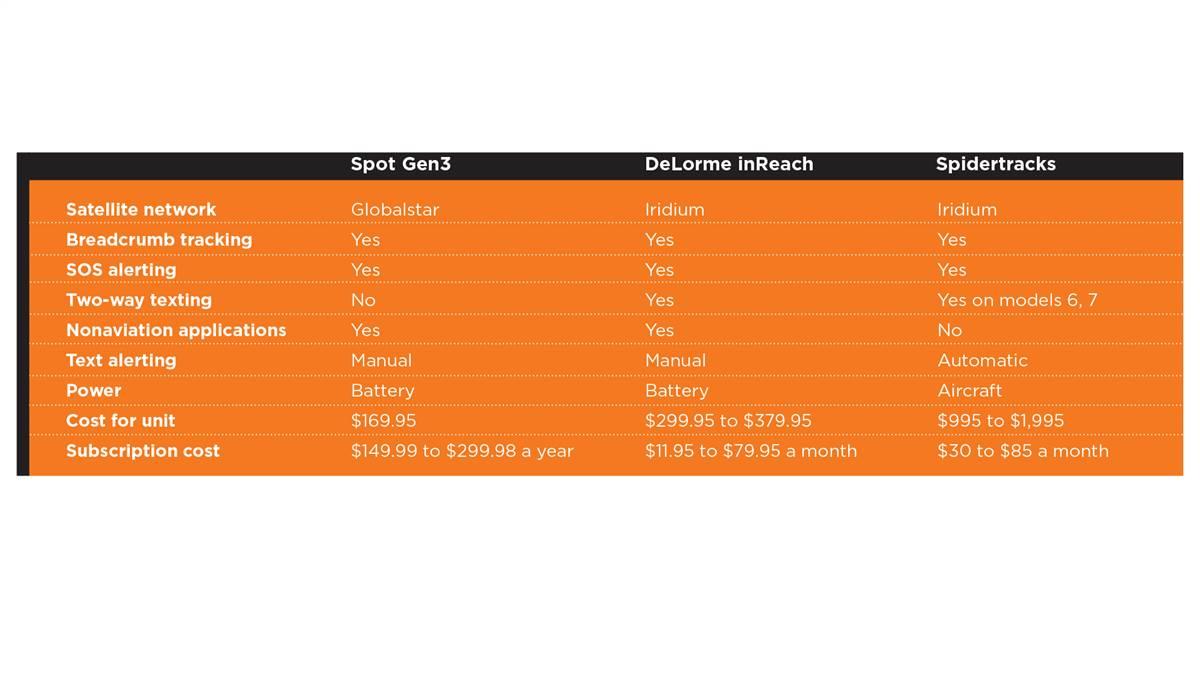Technology: Satellite Saviors
Exploring three safety devices

If it’s an older unit and broadcasting on 121.5 MHz, hopefully someone will be monitoring and call in the approximate location. With newer 406-MHz units, the cavalry can better pinpoint your position and get you out quickly.
But these devices are expensive uni-taskers. A selection of satellite-based messengers now on the market can both pinpoint your location in the event of a crash or off-airport landing, and communicate your position in real time to friends and family on all those days you fly around without crashing. A few even offer the capability to send text messages via the satellite connection.
Choosing the right device comes down to three basic factors—cost, coverage, and features. Spot, DeLorme, and Spidertracks generally own the satellite messenger market. Each provides a breadcrumb trail that’s easy for loved ones to follow on a map, and each has an emergency function that alerts authorities. The differences come in how each of these functions is accomplished, where coverage is available, and the cost.
Spot is the most basic of the three offerings. At $169.95 for its Gen3 model, plus $149.99 a year for service, Spot is the least expensive option. Spot uses the Globalstar network of satellites, which has limited coverage in certain parts of Alaska, Hawaii, and other parts of the world. The Gen3 messenger is easy to use. Once your account is configured, you simply power it up and set it on the glareshield for the breadcrumbs to start. Preselected messages can be sent, including requests for help where true emergency services aren’t required.
Choosing the right device comes down to three basic factors—cost, coverage, and features.DeLorme’s inReach represents the next step up in capability. The small phone-like unit operates on the Iridium network, a worldwide constellation of satellites the company says can cover you from pole to pole. DeLorme, which is a Garmin subsidiary, has two basic offerings, the Explorer and the SE. Both offer breadcrumb tracking, search and rescue alerting, and two-way text-messaging capability. The Explorer additionally includes a compass, altimeter, accelerometer, and some basic navigation and waypoint tracking, although this feature is meant more for ground-based activities.
The Explorer retails for $379.95, and the SE retails for $299.95. Annual plans range from $11.95 a month to $79.95 a month, each offering a different level of tracking interval and text message pricing. Like Spot, the unit must be manually powered on and tracking must be enabled.
Spidertracks represents the top-tier solution for satellite tracking and messaging. It is the most expensive option at $995 for Spidertracks 3, $1,495 for Spidertracks 6, and $1,995 for Spidertracks 7. Add in a subscription fee of between $30 a month and $85 a month for noncommercial use, and the price starts to add up.
The biggest advantage Spidertracks holds over the other devices is that it all happens in the background. The unit is powered either through the cigarette lighter or hard-wired to the aircraft. It starts up on battery power, keeps track of takeoff and landing times, and tracks flights—all without pilot intervention. Users can set alerts via Email or text for these phases of flight, and tracking is done through a simple web interface.
All the Spidertracks models include the ability to alert emergency authorities, and if those text or Email alerts are enabled, someone tracking the flight on the ground also will know immediately that something is amiss. Additionally, Spidertracks 6 and 7 include text messaging capability and altitude alerting.
The downside is that Spidertracks is an aircraft-specific device. Whereas Spot and inReach work for boating, hiking, and driving in remote areas, Spidertracks is purpose built. It operates on the Iridium network, so worldwide coverage is assured.
If being found is all that matters in an off-airport landing—and it’s hard to imagine a more pressing objective—a relatively inexpensive satellite messaging device seems like cheap insurance. The choice comes down to cost, where you fly, and how interested you are in interacting with the system. Spot, inReach, and Spidertracks all represent a great method to get help when you need it most.

Email [email protected]


